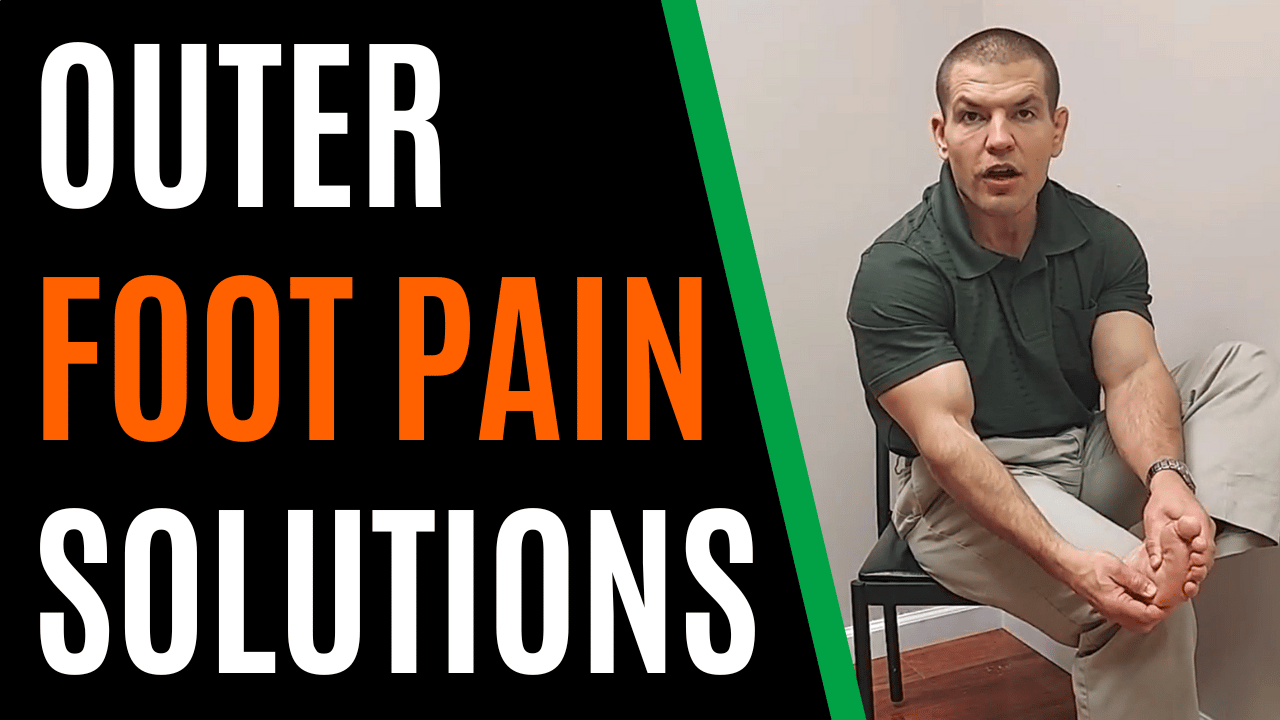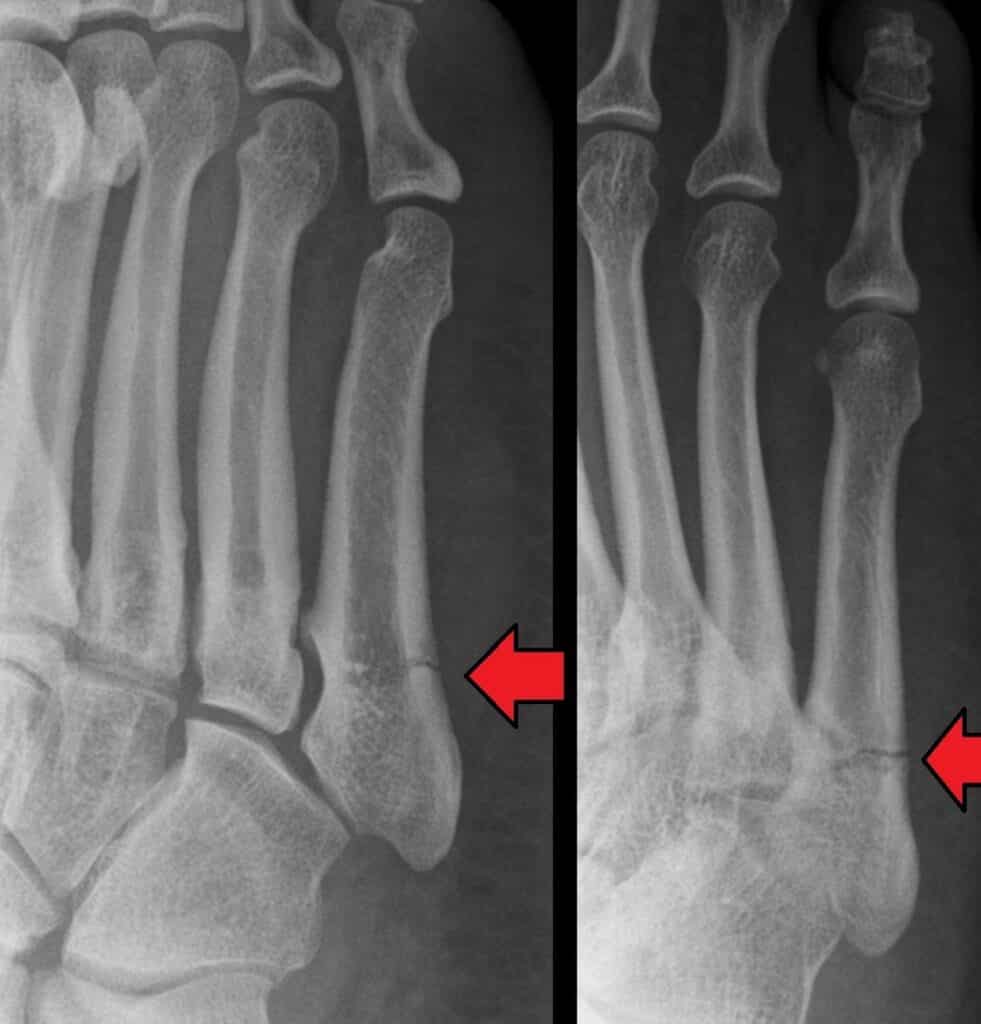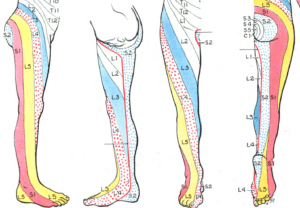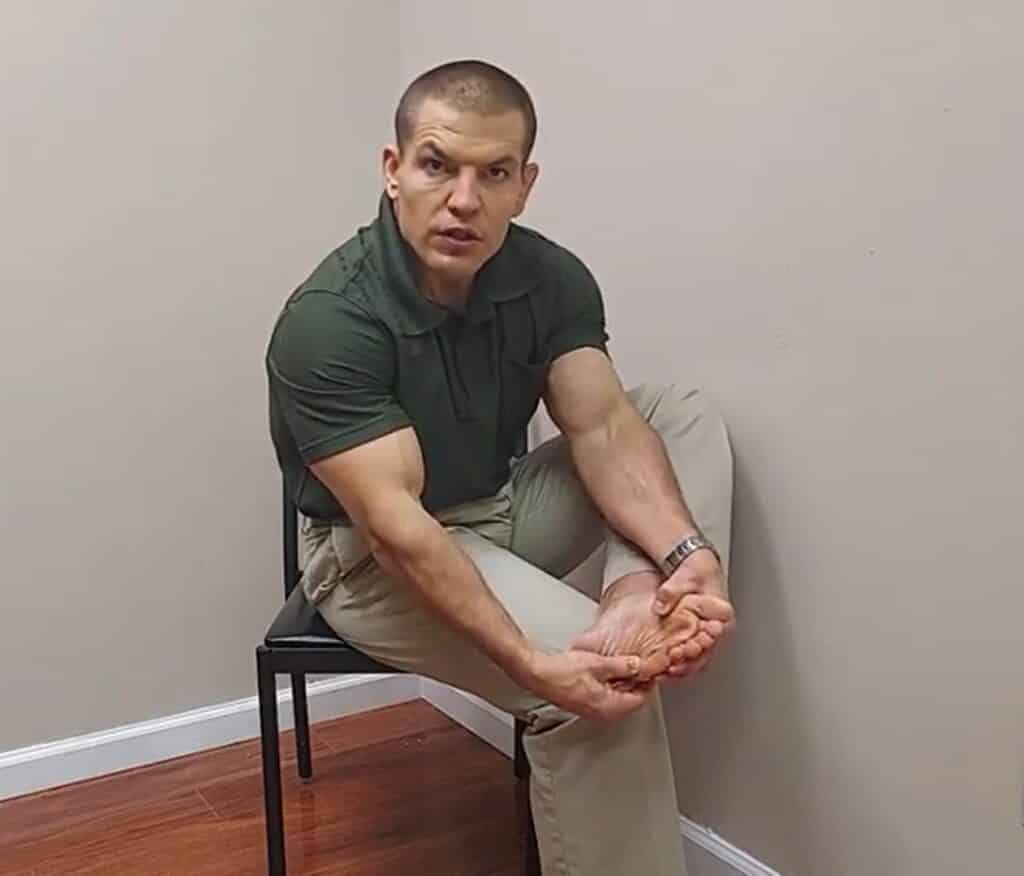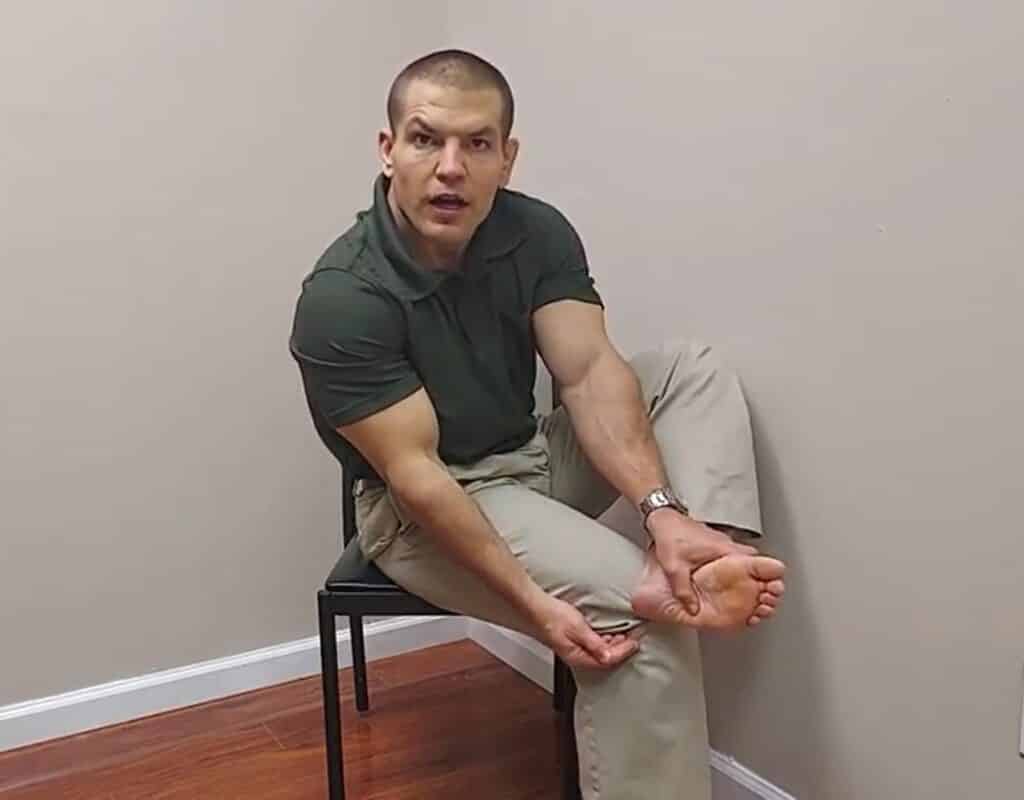This Little-Known Trick Can Help Pain On The Outside Of The Foot
Watch this video to learn what causes pain on the outside of the foot, plus a secret trick to help the most common cause of pain on the outside of the foot.

What Causes Pain On The Outside Of The Foot?
There are several things that can cause pain on the outside of the foot, but most of them aren't serious problems.
Causes of pain on outside of the foot include:
- 5th metatarsal fracture
- Lower back (S1) radiculopathy
- Peripheral nerve problems
- Cuboid dysfunction (most common)
5th Metatarsal Fracture (Jones Fracture)
A 5th metatarsal fracture (also called a Jones fracture) is a break of the bone on the outside of the foot connected to your pinky toe. The image below shows an xray of a fractured 5th metatarsal.
If you have pain on the outside of the foot, you want to first make sure that a fracture isn't the cause of your pain.
Fortunately, there's a very easy and reliable clinical test to tell if you have a fracture on the outside of your foot without needing x-rays.
That rule is called the Ottowa Foot Rules.
The Ottowa Foot Rules (part of the Ottowa Ankle Rules) state that if you don't have bony tenderness over the 5th metatarsal and you can bear weight and take 4 steps, you can rule out a fracture.
If you DO have bony tenderness or can't bear weight, you should get a foot x-ray to rule out a fracture.
If a fracture is present, treatment will usually include wearing a cast or walking boot for 9-12 weeks.
If the fracture is displaced, surgical fixation of the fracture may be needed.
In either case. physical therapy will be needed following immobilization to regain ankle range of motion, normalize walking pattern, and return to sports or other activities.
Need Physical Therapy For Pain On Outside Of The Foot?
Tap the button below to request an appointment with one of our specialist physical therapists.
Pain On Outside Of The Foot From Lower Back (S1)
The S1 nerve root exits the lower back at the space between the L5 and S1 vertebrae. A bulging, herniated, or degenerative disc at L5-S1 can cause pain on the outside of the foot as well as numbness and tingling in the leg and foot.
Less common causes of outer-foot pain include referrals from the lower back, such as an S1 radiculopathy, which results in numbness down your leg(s) to the outside and underside of the foot.
Make sure to find out more about this condition if you think that your outer foot pain feels like numbness related to your legs and lower back.
Peripheral Nerves Dysfunctions
Peripheral branches of the S1 nerve can also cause pain on the outside of the foot.
The lateral dorsal cutaneous branch of the sural nerve or the lateral plantar branch of the tibial nerve can both cause pain on the outside of the foot.
Either of these nerves can be irritated by stiff calf muscles or poor walking or running mechanics. Stretching your calves or wearing orthotics can help with these causes of pain on the outside of the foot.
Pain On Outside Of The Foot From Cuboid Dysfunction
One of the most common causes of pain on the outside of the foot is from a cuboid dysfunction.
The cuboid is a bone in your midfoot that joins the heel bone (calcaneus) with the 4th and 5th metatarsals of the forefoot.
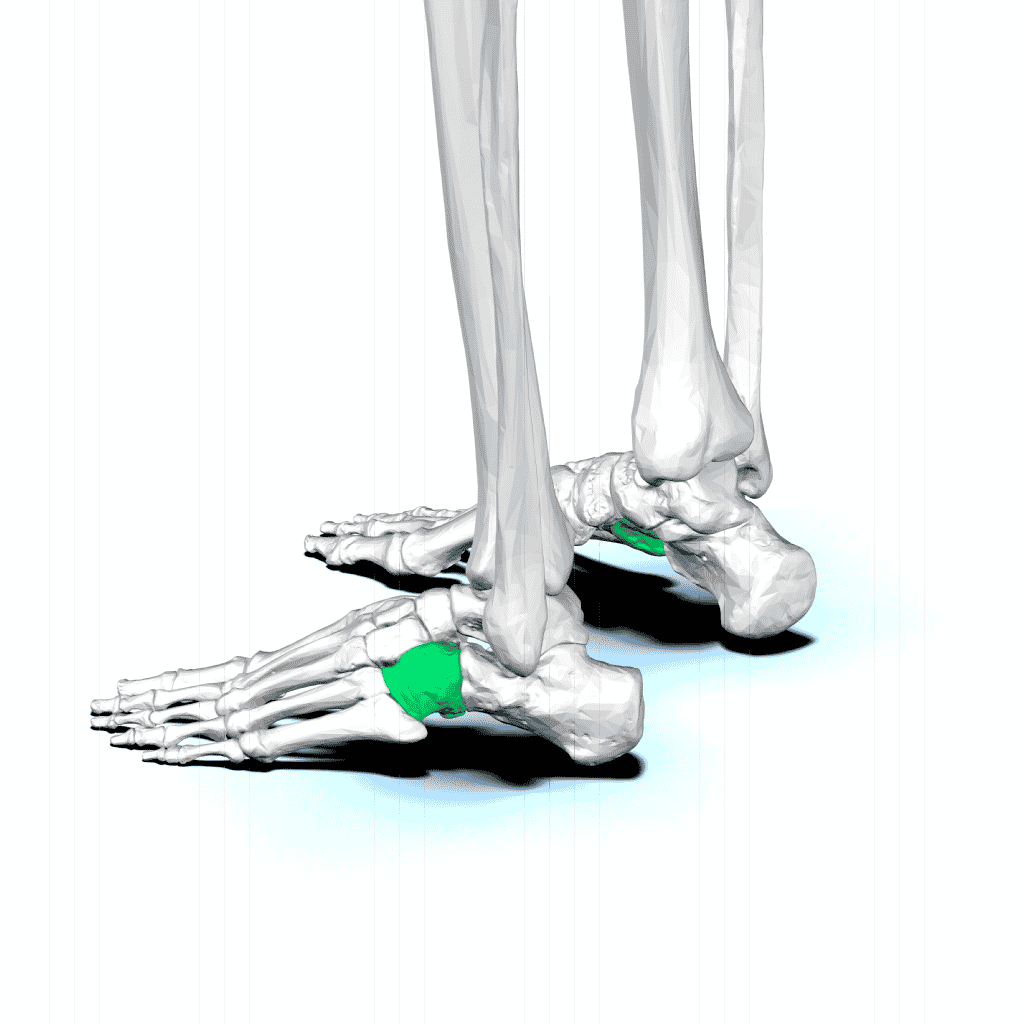
If you overpronate excessively when walking or running, the cuboid bone cane "drop" down out of the arch and can cause pain on the outside of the foot.
It may feel like you've got a pebble in your shoe. Usually a cuboid dysfunction won't completely stop you from bearing weight on the foot, but it may during activities such as running, prolonged walking, or walking barefoot.
How can you tell if a cuboid dysfunction is the cause of your foot pain?
Well, if you push on your foot just behind the bump on the outside of the foot (the 5th metatarsal as noted above), the cuboid bone will be tender on the bottom of the foot.
(Note: This is different from the 5th metatarsal tenderness, which as noted above may be a sign of a fracture.)
How you treat a cuboid dysfunction?
Well, you need to push it back up into the arch where it belongs.
A manual physical therapist (like our physical therapists) can do a quick manipulation to push the bone back up into the arch where it belongs.
However, if you aren't ready to request an appointment yet, there's a self-mobilization that you can do at home to relieve pain on the outside of the foot from a cuboid dysfunction.
Self-Mobilization For Pain On The Outside Of The Foot
Grasp your foot with one hand as shown below with your thumb on the bottom of the cuboid bone. Then wrap your other hand around the top of your foot and pull the forefoot down while pushing the cuboid upward.
Alternatively, you can use a different handhold, as shown below with the opposite thumb on the cuboid bone.
Then, use your other hand to pull the outer foot downward while holding the cuboid in place with your thumb as shown below. See the video at the top of this page for a full description of how to do this self-mobilization.
Additional Options To Help Pain On Outside Of The Foot
Although the cuboid mobilization shown above can help relieve a cuboid dysfunction, if you continue to over-pronate your feet, the cuboid bone is just going to pop right back out of place.
Stretching your calves can help prevent this from happening. However, most people do calf stretches wrong.
Click here to learn how to stretch your calves correctly.
Additionally, it’s also a good idea to have orthotics
However, most off-the-shelf orthotics only support the inner arch of the foot (medial longitudinal arch - Line A-C in the image below.
In order to prevent a cuboid dysfunction from occurring, your orthotics also need to support the outside arch of the foot (lateral longitudinal arch - Line B-C in the image below)
At More 4 Life, we offer custom orthotics that support all 3 of your arches of your foot.
Tap the button below to request a Free Orthotic Foot Scan
Don't Forget Everything ABOVE The Foot
No part of your body can be treated in isolation.
Overpronation can be a major cause of a cuboid dysfunction, but what causes over-pronation in the first place?
(Hint: It's not just flat feet)
Overpronation is usually a compensation for something else that's going wrong.
As mentioned above, stiff calves are one example.
However, other causes of overpronation include:
- Scoliosis
- One leg being longer than the other
- Weak hip muscles
- A pinched nerve in the lower back causing hip weakness
In order to get rid of your foot pain, and keep it from coming back in the future, you need to make sure to identify and treat the root cause of your foot pain.
Want To Discover The Root Cause Of Your Foot Pain & How To Fix It?
Tap the button below to request a Free Discovery Visit with one of our specialists

